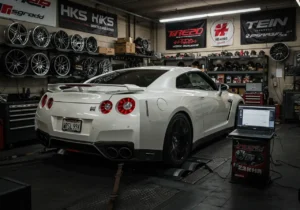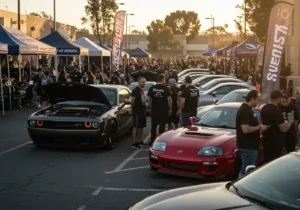Performance upgrades breathe new life into cars, unlocking speed, handling, and reliability well beyond what rolled out of the factory. Whether you drive a Detroit muscle car or a precision-tuned import, the urge to push boundaries is universal among enthusiasts. Yet, the path to higher performance isn’t identical for every vehicle.
Domestic vs Import Performance Upgrades: Key Differences become clear as soon as you start comparing the parts, labor, and culture surrounding each type.
- Domestic vehicles—typically American-made—often benefit from a vast network of local suppliers, straightforward engineering, and widespread mechanic familiarity.
- Import vehicles—brought in from foreign manufacturers—offer distinct platforms prized for their unique engineering and styling cues, but can present hurdles in sourcing parts or specialized expertise.
Understanding these key differences is crucial before investing time or money into upgrades. The right information helps you avoid costly mistakes and ensures every modification matches your driving goals.
Exploring both sides of this coin reveals not only technical variances but also the cultural influences shaping how owners approach tuning. Whether your passion lies in straight-line power or razor-sharp handling, knowing where domestic and import upgrade paths diverge empowers you to make informed decisions about your build.
1. Understanding Vehicle Origin and Parts Availability
Vehicle origin plays a crucial role in performance upgrades, influencing both the availability of parts and the types of modifications that can be made. Domestic vehicles are those manufactured within the country, such as American-made cars in the U.S. Imported cars, on the other hand, are foreign-made vehicles brought into the country.
The Advantage of Domestic Vehicles
When it comes to parts availability, domestic vehicles often have a significant advantage. Local manufacturing and distribution networks ensure that replacement parts and aftermarket performance components are readily accessible. This accessibility not only simplifies maintenance but also opens up a wide range of upgrade options for enthusiasts.
For example:
- Domestic Vehicles: Easier access to parts means you can find high-performance components such as upgraded exhaust systems, suspension kits, and engine enhancements without much hassle.
Challenges Faced by Imported Cars
Import cars may face challenges in obtaining parts, particularly if they are rare or niche models from abroad. Sourcing specific components can be time-consuming and costly, impacting both maintenance expenses and upgrade possibilities.
For example:
- Imported Cars: Finding parts might require importing directly from the vehicle’s country of origin or seeking specialized vendors who cater to foreign brands.
The impact of vehicle origin on upgrade options is significant. Domestic car owners benefit from a broad selection of locally available aftermarket products, while import enthusiasts must often navigate limited availability and higher costs for specialized parts. The choice between domestic and imported vehicles thus has substantial implications for anyone looking to enhance their car’s performance capabilities.
 2. Comparing Maintenance and Repair Costs
2. Comparing Maintenance and Repair Costs
Maintenance costs and repair costs are crucial considerations when deciding between domestic and imported vehicles. Domestic cars often have lower maintenance expenses due to several factors:
- Mechanic familiarity: Local mechanics are typically more familiar with domestic vehicles, leading to quicker diagnostics and repairs.
- Labor expenses: Labor costs may be lower for domestic cars as they are generally more straightforward to service.
- Parts availability: Replacement parts for domestic cars are usually easier to source, reducing downtime and costs.
Imported vehicles can present higher maintenance costs influenced by:
- Specialized knowledge: Mechanics may require specialized training or experience to work on imported models, sometimes resulting in higher labor fees.
- Parts sourcing difficulties: Imported cars might face challenges in accessing parts, especially for rare or niche models. This scarcity can increase both the price of parts and the time needed for repairs.
- Complex systems: Some imported vehicles feature advanced technology that can complicate maintenance and repair processes.
In summary, while domestic cars benefit from lower maintenance costs due to accessibility and familiarity, imported vehicles face unique challenges that can elevate their repair costs. Understanding these differences is essential for making informed decisions about vehicle ownership and performance upgrades.
3. Exploring Performance Tuning Culture Differences
Performance tuning culture shapes the way enthusiasts approach domestic vs import performance upgrades. You’ll notice distinct philosophies and priorities between these two camps, each driven by regional heritage, available technology, and enthusiast communities.
Domestic Vehicles: Powertrain Enhancements
The focus often lies on powertrain enhancements. Owners of American muscle or classic domestics typically seek raw horsepower gains through engine swaps, superchargers, or upgraded exhaust systems. Straight-line speed is a common goal, reflected in the popularity of drag racing and dyno competitions. Visual cues like aggressive hood scoops or wide tires signal serious power under the hood.
Import Vehicles: Lightweight Modifications and Handling
The culture leans heavily toward lightweight modifications, suspension tuning, and turbocharging smaller engines. Japanese Domestic Market (JDM) builds exemplify this with coilover kits, forged wheels, strut bars, and precision turbo setups from renowned brands such as HKS or Greddy. Aesthetic body kits—often inspired by Japanese street racing or anime—transform the car’s appearance while improving aerodynamics. Handling and nimble response are prized over brute force.
“It’s not just about how fast you go in a straight line; it’s about how you take a corner,” says many import enthusiasts—a mindset that directly contrasts with the traditional muscle car ethos.
Cultural preferences dictate everything from part selection to event participation, creating two parallel yet intertwined worlds within the performance community. This dynamic helps keep the rivalry fresh and innovation constant as each side pushes boundaries in its own unique way.
4. Unique Challenges Faced by Import Enthusiasts
Import enthusiasts face a unique set of challenges when upgrading performance vehicles that are different from the usual domestic experience. These challenges often arise from the car’s foreign origin and limited regional support.
Here are some common challenges faced by import enthusiasts:
- Parts Scarcity: Sourcing high-performance or even basic replacement parts can be time-consuming and costly. Many imported cars require specialty components that aren’t stocked by local suppliers, leading to long shipping times and increased prices.
- Compatibility Issues: Aftermarket parts are frequently designed for domestic markets, so adapting them to fit specific import models may demand custom fabrication or specialized adapters.
- Technical Expertise: Not every mechanic is familiar with the engineering standards or diagnostic protocols of imported vehicles. This lack of expertise can complicate installation, troubleshooting, and ongoing maintenance.
- Regulatory Hurdles: Certain imports, especially those not originally sold in the region, may face stricter emissions standards or compliance checks, adding complexity to legal street use after modifications.
For many import owners, overcoming these hurdles becomes part of the journey—transforming each challenge into a badge of dedication within the community.
5. Examples of Domestic and Import Builds
Domestic Performance Builds
A domestic performance build often starts with a platform like a Ford Mustang, Chevrolet Camaro, or Dodge Charger. Common upgrades include:
- Engine modifications: High-flow cold air intakes, performance camshafts, and supercharger or turbocharger kits.
- Exhaust systems: Long-tube headers paired with cat-back exhausts for improved airflow and aggressive sound.
- Suspension upgrades: Adjustable coilovers or sway bars to enhance handling without sacrificing straight-line speed.
- Braking components: Upgraded big brake kits from brands like Brembo to handle increased power.
- Drivetrain enhancements: Heavy-duty clutches and limited-slip differentials for better traction during hard launches.
Import Performance Builds
An import build typically features platforms such as the Nissan 350Z, Subaru WRX STI, or Toyota Supra. Enthusiasts frequently install:
- Turbocharger kits: Bolt-on turbo setups from HKS or Greddy to extract maximum power from smaller displacement engines.
- Coilover suspension: Adjustable dampers from Tein or KW for precision handling on winding roads and tracks.
- Lightweight wheels: Japanese forged wheels like Volk Racing TE37s to reduce unsprung weight.
- Aerodynamic body kits: JDM-style bumpers, diffusers, and spoilers that provide both aesthetic appeal and functional downforce.
- ECU tuning: Standalone engine management systems for custom fuel and ignition mapping tailored to each modification.
Both domestic and import builds reflect unique philosophies—domestic cars often chase raw horsepower while imports prioritize balanced performance. Each path offers distinct advantages through specific aftermarket components tailored to its origins. For instance, a Z3 performance upgrade could involve similar principles as those applied in an import build.
 6. The Role of Events & Community in Shaping the Scene
6. The Role of Events & Community in Shaping the Scene
Drag racing competitions, vendor midways, and other automotive gatherings play a crucial role in shaping the vibrant culture surrounding domestic and import performance upgrades. These events serve as a melting pot for enthusiasts to showcase their builds, exchange knowledge, and celebrate their shared passion for automotive excellence.
Drag Racing Competitions:
- Drag racing events offer a platform for both domestic and import vehicles to demonstrate their raw power and acceleration capabilities.
- Participants compete in various classes tailored to different types of builds and modifications, highlighting the diversity within the performance upgrade community.
- Spectators witness firsthand the differences in tuning approaches, such as muscle cars’ straight-line speed versus the nimble handling of JDM sports cars.
Vendor Midways:
- Vendor midways at these events provide access to a wide range of performance parts catering to both domestic and import vehicles.
- Suppliers showcase cutting-edge components, from high-performance brakes and suspension kits to turbochargers and body kits.
- Enthusiasts can interact with vendors, gaining insights into the latest trends and technologies in automotive performance.
Community Gatherings:
- Local car meets, track days, and automotive festivals foster a sense of camaraderie among participants.
- These gatherings allow enthusiasts to share their experiences, discuss challenges faced during upgrades, and offer support and advice.
- The community-driven aspect helps maintain the momentum of innovation within both domestic and import performance scenes. For instance, joining online platforms like this Facebook group can provide valuable resources and connections.
By participating in these events, enthusiasts not only enhance their vehicles but also contribute to the evolving landscape of automotive performance culture.
7. Making Informed Decisions When Choosing Upgrades
Choosing the right performance upgrades for your domestic or import vehicle comes down to balancing several practical considerations. Each decision impacts not only the driving experience but also long-term value and reliability.
Key Considerations When Choosing Upgrades:
- Budget Constraints
- Set a realistic budget before starting any upgrade project.
- Domestic upgrades often have lower entry costs due to wider local parts availability, but high-end components can still add up quickly.
- Import owners may deal with premium pricing on rare or specialty parts, as well as added shipping and import fees.
- Compatibility Research
- Not all aftermarket parts are a direct fit for every vehicle. Double-check that components are specifically designed for your make, model, and year.
- Domestic vehicles generally enjoy broader support from large aftermarket brands, making fitment easier.
- Import enthusiasts should pay special attention to part numbers, regional variations (e.g., JDM vs USDM), and whether modifications are needed for installation.
- Warranty Implications
- Performance upgrades can void manufacturer warranties or affect extended coverage plans.
- Always review warranty documentation before installing non-OEM parts.
- Some manufacturers offer “performance-friendly” warranties if approved parts are used—worth investigating if you want to keep coverage intact.
Pro Tip: Maintain thorough documentation of all upgrades and services; this helps with future resale, troubleshooting, and potential warranty discussions.
Factoring in these elements minimizes surprises during your build and ensures each upgrade aligns with your long-term goals for the vehicle.
Conclusion
When it comes to upgrading your vehicle’s performance, it’s important to embrace your personal preferences. Whether you prefer the power of domestic muscle cars or the precision of import vehicles, knowing the key differences between them will help you make better choices.
Take the time to explore the culture behind each type of car, do your research, and create a vehicle that truly represents your individual style and love for automobiles.

 2. Comparing Maintenance and Repair Costs
2. Comparing Maintenance and Repair Costs 6. The Role of Events & Community in Shaping the Scene
6. The Role of Events & Community in Shaping the Scene